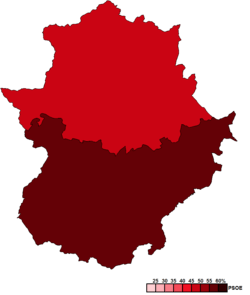Extremaduran regional election, 1983
|
| |||||||||||||||||||||||||||||||||||||||||||||||||||||||||||||
| |||||||||||||||||||||||||||||||||||||||||||||||||||||||||||||
All 65 seats in the Assembly of Extremadura 33 seats needed for a majority | |||||||||||||||||||||||||||||||||||||||||||||||||||||||||||||
|---|---|---|---|---|---|---|---|---|---|---|---|---|---|---|---|---|---|---|---|---|---|---|---|---|---|---|---|---|---|---|---|---|---|---|---|---|---|---|---|---|---|---|---|---|---|---|---|---|---|---|---|---|---|---|---|---|---|---|---|---|---|
| Registered | 786,200 | ||||||||||||||||||||||||||||||||||||||||||||||||||||||||||||
| Turnout | 565,244 (71.9%) | ||||||||||||||||||||||||||||||||||||||||||||||||||||||||||||
| |||||||||||||||||||||||||||||||||||||||||||||||||||||||||||||
 Constituency results map for the Assembly of Extremadura | |||||||||||||||||||||||||||||||||||||||||||||||||||||||||||||
| |||||||||||||||||||||||||||||||||||||||||||||||||||||||||||||
The 1983 Extremaduran regional election was held on Sunday, 8 May 1983, to elect the 1st Assembly of the Autonomous Community of Extremadura. All 65 seats in the Assembly were up for election. The election was held simultaneously with regional elections in twelve other autonomous communities and local elections all throughout Spain.
The Spanish Socialist Workers' Party (PSOE) under pre-autonomic President Juan Carlos Rodríguez Ibarra won the election with an absolute majority of seats. The People's Coalition, an electoral alliance led by the People's Alliance (AP) and including the People's Democratic Party (PDP) and the Liberal Union (UL), emerged as the second largest force obtaining 20 seats, with United Extremadura (EU) and the Communist Party of Spain (PCE) also entering the Assembly, winning 6 and 4 seats respectively.
Overview
Electoral system
The Assembly of Extremadura was the devolved, unicameral legislature of the autonomous community of Extremadura, having legislative power in regional matters as defined by the Spanish Constitution and the Extremaduran Statute of Autonomy, as well as the ability to vote confidence in or withdraw it from a President of the Regional Government.[1] Voting for the Assembly was on the basis of universal suffrage, which comprised all nationals over eighteen, registered in Extremadura and in full enjoyment of their political rights.
The 65 members of the Assembly of Extremadura were elected using the D'Hondt method and a closed list proportional representation, with a threshold of 5 percent of valid votes—which included blank ballots—being applied in each constituency. Parties not reaching the threshold were not taken into consideration for seat distribution. Alternatively, parties failing to reach the threshold in one of the constituencies would also be entitled to enter the seat distribution as long as they ran candidates in both districts and reached 5 percent regionally. Seats were allocated to constituencies, corresponding to the provinces of Badajoz and Cáceres. Each constituency was allocated a fixed number of seats: 35 for Badajoz and 30 for Cáceres.[1]
The electoral law provided that parties, federations, coalitions and groupings of electors were allowed to present lists of candidates. However, groupings of electors were required to secure the signature of at least 0.1 percent of the electors registered in the constituency for which they sought election—needing to secure, in any case, the signature of 500 electors—. Electors were barred from signing for more than one list of candidates. Concurrently, parties and federations intending to enter in coalition to take part jointly at an election were required to inform the relevant Electoral Commission within fifteen days of the election being called.[2]
Election date
The Junta of Extremadura, in agreement with the Government of Spain, was required to call an election to the Assembly of Extremadura before 31 May 1983. In the event of an investiture process failing to elect a regional President within a two-month period from the first ballot, the Assembly was to be automatically dissolved and a snap election called, with elected deputies merely serving out what remained of their four-year terms.[1]
Results
Overall
 | ||||||
| Parties and coalitions | Popular vote | Seats | ||||
|---|---|---|---|---|---|---|
| Votes | % | ±pp | Total | +/− | ||
| Spanish Socialist Workers' Party (PSOE) | 296,939 | 53.02 | n/a | 35 | n/a | |
| People's Coalition (AP–PDP–UL) | 168,606 | 30.10 | n/a | 20 | n/a | |
| United Extremadura (EU) | 47,504 | 8.48 | n/a | 6 | n/a | |
| Communist Party of Spain (PCE) | 36,294 | 6.48 | n/a | 4 | n/a | |
| Democratic and Social Centre (CDS) | 4,414 | 0.79 | n/a | 0 | n/a | |
| Extremaduran Popular Bloc (BPEx) | 2,249 | 0.40 | n/a | 0 | n/a | |
| Spanish Communist Workers' Party–Unified Communist Party (PCOE–PCEU) | 1,463 | 0.26 | n/a | 0 | n/a | |
| Blank ballots | 2,622 | 0.47 | n/a | |||
| Total | 560,091 | 65 | n/a | |||
| Valid votes | 560,091 | 99.09 | n/a | |||
| Invalid votes | 5,153 | 0.91 | n/a | |||
| Votes cast / turnout | 565,244 | 71.90 | n/a | |||
| Abstentions | 220,956 | 28.10 | n/a | |||
| Registered voters | 786,200 | |||||
| Sources[3][4][5] | ||||||
Distribution by constituency
| Constituency | PSOE | CP | EU | PCE | ||||
|---|---|---|---|---|---|---|---|---|
| % | S | % | S | % | S | % | S | |
| Badajoz | 56.6 | 20 | 30.9 | 11 | 3.4 | 1 | 8.3 | 3 |
| Cáceres | 47.5 | 15 | 29.0 | 9 | 16.3 | 5 | 3.7 | 1 |
| Total | 53.0 | 35 | 30.1 | 20 | 8.5 | 6 | 6.5 | 4 |
References
- 1 2 3 "Statute of Autonomy of Extremadura of 1983". Organic Law No. 1 of 25 February 1983. Official State Gazette (in Spanish). Retrieved 17 March 2017.
- ↑ "Electoral Rules Decree of 1977". Royal Decree-Law No. 20 of 18 March 1977. Official State Gazette (in Spanish). Retrieved 27 December 2016.
- ↑ "Assembly of Extremadura election, 1983". datoselecciones.com (in Spanish). Election Data. Retrieved 26 September 2017.
- ↑ "Assembly of Extremadura election results, 8 May 1983. Badajoz and Cáceres" (PDF). juntaelectoralcentral.es (in Spanish). Central Electoral Commission. 12 September 1983. Retrieved 26 September 2017.
- ↑ "Assembly of Extremadura elections since 1983". historiaelectoral.com (in Spanish). Electoral History. Retrieved 26 September 2017.
.jpg)
